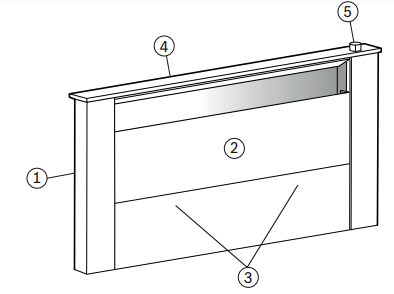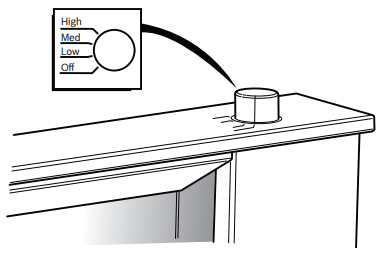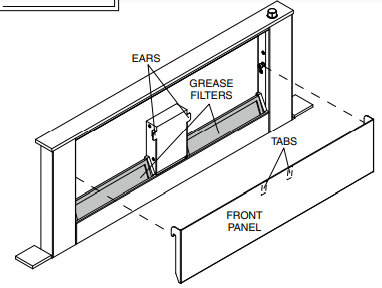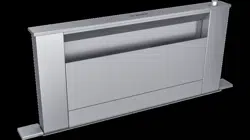Documents: Go to download!
User Manual
- Owner's manual - (English, French, Spanish)
- Product spec sheet - (English)
- Causes For Damages
- Features
- Operating the Appliance
- Cleaning and Maintenance
- Troubleshooting
Table of contents
Causes For Damages
CAUTION: Risk of damage due to corrosion. Always turn appliance on when cooking to avoid condensation buildup. Condensation can lead to corrosion damages.
Risk of damage due to moisture entering into the electronic circuitry. Never clean operator controls with a wet cloth.
Surface damage due to incorrect cleaning. Clean stainless steel surfaces in the grain direction only. Do not use any stainless steel cleaners for operator controls. Never use strong or abrasive cleaning agents, since they can cause surface damage.
Risk of damage from condensation back flow. Install exhaust vent at a slight downward slope away from the appliance (1° slope).
Features
The Downdraft Hood takes the place of an overhead hood and can be conveniently hidden away (lowered) when not in use. It has a blower fan that draws the cooking byproducts into the intake housing, through two filters and out of the house or recirculated back into the home with the separate purchase of a recirculation kit.

- Raised Intake Housing
- Removable Front Panel
- Filters (behind removable front panel)
- Intake Top Cap
- Intake Up / Down Pushbutton
Raised Intake Housing
The intake housing, when raised, captures and channels the cooking odors, steam and grease from the cooktop through two filters located within the intake housing.
The air is cleaned by the filters and conveyed to the building exterior by a series of pipe ducts.
NOTE: Ventilation may not exit through an already operational smoke or exhaust chimney, nor a duct used for ventilating furnace installation areas.
If the ventilation is intended to pass through a smoke or exhaust that is not in operation, the responsible area heating inspector must give approval.
If the ventilation passes through an external wall, use a telescopic wall sleeve.
Intake Up/Down Pushbutton
The UP/DOWN operation of the Downdraft Hood is controlled by the control switch located on the top right side of the intake housing. Press and release the switch button once to raise or lower the Hood Housing.
Blower
The blower is also controlled by pressing or rotating the control switch on the top right of the intake housing. The blower has four settings: Off, Low, Medium, and High, and will operate whenever the intake housing is in the raised position.
NOTE: The intake housing can be lowered without turning the blower switch to the Off position. Press the switch button once to turn the fan Off and lower the intake housing. Press the switch again and the intake housing will raise and the blower will turn On to its previous operating position.
Filters
The filters are located on the bottom of the intake housing, behind the removable front panel. They condense and trap the grease in the air. Filters include protective film that must be removed before use.
Operating the Appliance
Always turn the downdraft blower on before you begin cooking to establish an air fl ow in the kitchen. Let the blower run for a few minutes to clean the air after you turn the cooktop off. This will keep the whole kitchen cleaner and brighter.
It is recommended to use the rear burners when cooking with tall pots or when the cooking method will generate high amounts of smoke or steam. The combination of using the rear burners and operating the unit at high speed will increase the likelihood that all the smoke and steam will be removed by the downdraft.
All functions of the Downdraft Hood are controlled with the control knob on the right side of the top panel.

To Raise the Hood Intake Housing:
Press and release the control switch.
NOTE: If the hood was lowered with the blower in any operating position, it will start and return to the previously set speed when the hood is fully raised.
To Lower the Hood Intake Housing:
Press and release the control switch.
NOTE: If the blower is in operation when the hood is lowered, the blower will shut off before lowering.
If Hood Intake Housing Movement Stops:
Locate and remove obstruction.
Control Blower Speeds:
Rotate the control knob to one of four positions
- Off
- Low
- Medium
- High
Cleaning and Maintenance
The efficiency of the downdraft ventilation system depends on the cleanliness of the intake housing and filters. The frequency of cleaning depends on the amount and type of cooking.
Always use the mildest cleaner that will do the job. Use clean, soft cloths or sponges only.
Use all products according to package directions.
Rub stainless steel finishes in the direction of the grain. Wipe area dry to avoid water marks.
After cleaning, place all parts in their proper positions before using.
Do not use the ventilating system without the filters in place or with grease-laden filters or surfaces.
Do not use steam cleaners to clean the appliance.
Hidden surfaces may have sharp edges. Use caution when reaching behind or under appliance.
WARNING
To avoid risk of fire and explosion do not use flammable liquids or solvents.
Always unplug or disconnect the appliance from the power supply before servicing.
WARNING: RISK OF BURNS
The appliance will become hot when in use. Let cool before cleaning.
WARNING: RISK OF ELECTRIC SHOCK
Moisture penetration can cause electric shock.
Only clean appliance with a damp cloth. Prior to cleaning, pull the plug or flip the breaker in the fusebox.
For best performance: Replace grease filters with half-moon openings facing out - and in orientation shown.


Clean Grease Filters:
To remove front panel, lift the panel up and pivot out at an angle. The panel can be removed fully.
Once the front panel is removed, take out the (2) grease filters.
WARNING: RISK OF FIRE
Grease deposits in the grease filters can ignite.
Clean the grease filters at least every two months or as frequently as necessary. Never operate the appliance without the grease filters.
NOTES:
- DO NOT use any aggressive, acidic or alkaline cleaning agents.
- DO NOT use abrasive products such as steel wool.
- DO NOT use cellulose sponges. Some sponges are processed with salt and can cause corrosion by leaving salt deposits on the metal.
- DO NOT allow any cleaning compounds to remain in contact with stainless steel for extended periods.
- DO NOT USE CHLORINE-BASED CLEANERS.
- When cleaning the grease filters, also clean the metal grease filter holder in the appliance with a moist cloth.
- Clean all-metal filters in the dishwasher using a nonphosphate detergent. Discoloration of the filters may occur if using phosphate detergents, or as a result of local water conditions - but this will not affect filter performance. This discoloration is not covered by the warranty. To minimize or prevent discoloration, hand wash filters using a mild detergent.
In the dishwasher:
NOTE: Slight discoloration is possible when cleaning the grease filters in the dishwasher. This is normal and does not affect the performance of the grease filters.
- Do not clean extremely dirty grease filters with dishes.
- Loosely position the grease filters in the top rack of the dishwasher. Wash the filters through on Normal cycle. The grease filters must not be jammed in.
Replace filters and front panel before using downdraft. Make sure that the filters are seated properly.
To replace the front panel, align the brackets at the bottom and pivot the panel inwards until it sits in place or the TABS are engaged.
CAUTION: Failure to engage tabs properly may cause chimney to jam and fail to raise up.
By hand:
NOTE: You can use a degreaser if soiling is stubborn. You can order it via the online shop.
- Soak the grease filters in warm soapy water for 10-15 minutes using a mild detergent.
- Use a brush for cleaning and then rinse the filters well.
- Allow the grease filters to drip dry completely before placing them back into the downdraft.
Clean and dry intake housing, then reinstall or replace filters before using downdraft.
Clean Intake Housing:
- Pull front panel up and out.
- Remove both filters.
- Use a mild detergent. DO NOT USE ABRASIVE CLOTH, STEEL WOOL PADS, OR SCOURING POWDERS.
- Clean and reinstall or replace both filters and install front panel before using downdraft.
NOTICE: The use of brand names is intended only to indicate a type of cleaner. This does not constitute an endorsement. The omission of any brand name cleaner does not imply its adequacy or inadequacy. Many products are regional in distribution and can be found in the local markets. It is imperative that all products be used in strict accordance with instructions on the package.
NOTE: Do not use cooktop while hood is disassembled.
Charcoal Filter Replacement
It is recommended that you replace the recirculation filter every 6 months. However, this may vary, depending upon the type and amount of cooking you do.
To change the charcoal filter, remove the decorative cover plate (on toe kick or base of the cabinet) and replace the charcoal filter by a new one, part number HDDFILTUC. Reinstall the decorative cover plate.
Cleaning Agents
To prevent various surfaces from becoming damaged due to incorrect cleaning agents, follow the specifications given in the table. Do not use:
- cleaning agents that are harsh or scouring,
- cleaning agents with high alcohol content,
- hard scouring pads or sponges,
- high-pressure cleaners or steam cleaners.
Rub stainless steel finishes in the direction of the grain. Wipe area dry to avoid water marks. After cleaning, place all parts in their proper positions before using.
Thoroughly rinse all new sponges before use. Observe all instructions and warnings accompanying cleaning agents.
| Area | Cleaning agents |
| Stainless steel | Warm soapy water: Clean with a dish rag and dry with a soft towel. Only clean stainless steel with the grain. Specific products for stainless steel care are available from customer service or from specialized retailers. Apply a thin layer of the care product with a soft cloth. |
| Varnished surfaces | Warm soapy water: Clean with a damp dish rag and dry with a soft towel. Do not use stainless steel cleaner. |
| Aluminum and plastic | Glass cleaner: Clean with a soft cloth. |
| Glass | Glass cleaner: Clean with a soft cloth. Do not use a glass scraper. |
| Controls | Warm soapy water: Clean with a damp dish rag and dry with a soft towel. Risk of damage to electronics due to moisture penetration. Never clean controls with a wet cloth. Do not use stainless steel cleaner. |
Troubleshooting
You can often easily eliminate problems that may occur on your own. Before calling customer service, take into account the following information.
WARNING: RISK OF ELECTRIC SHOCK
Improper repairs are dangerous. Only an authorized servicer may perform repairs and may replace damaged wiring. Unplug the appliance or switch power off at the service panel if the appliance needs servicing. Call an authorized servicer.
Troubleshooting Tips:
- If the downdraft stops working, check the power cord and the connections to the electrical boxes, a connection may have come loose.
- If the downdraft unit stops working or the unit malfunctions, unplug the unit, wait 30 seconds, and plug it back in to reset.
- If gas burners click or go out on low when the downdraft is operating, check that the blower and ductwork below are properly sealed.
- If the front cover rattles, slide it left or right. The tolerance is to allow for heating and simple removal.
- If an obstruction is placed into the unit, the safety mechanism will activate. Remove the obstruction and the unit should reset.
See other models: NWP645CB2M/03 KIL1540/44 SMP46MW03S/51 HMC54151UC/05 HBM13B120B/35
